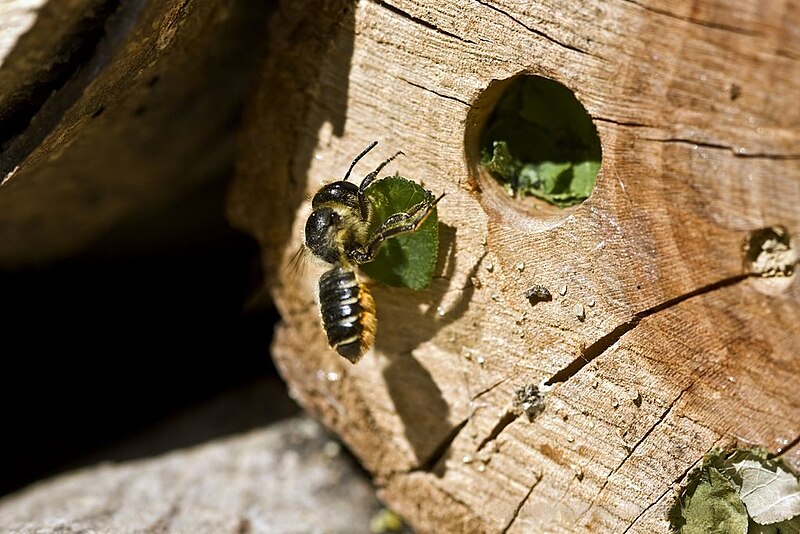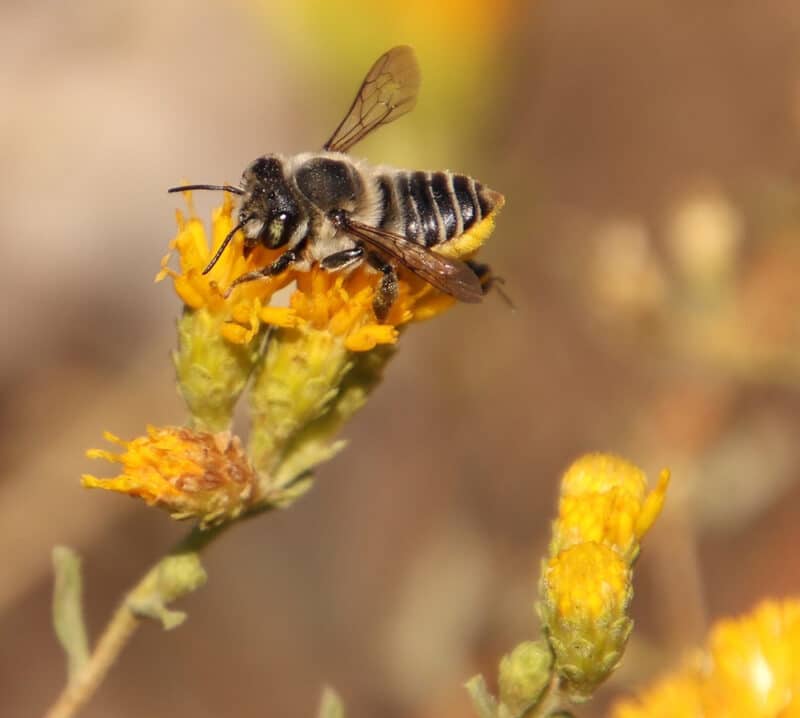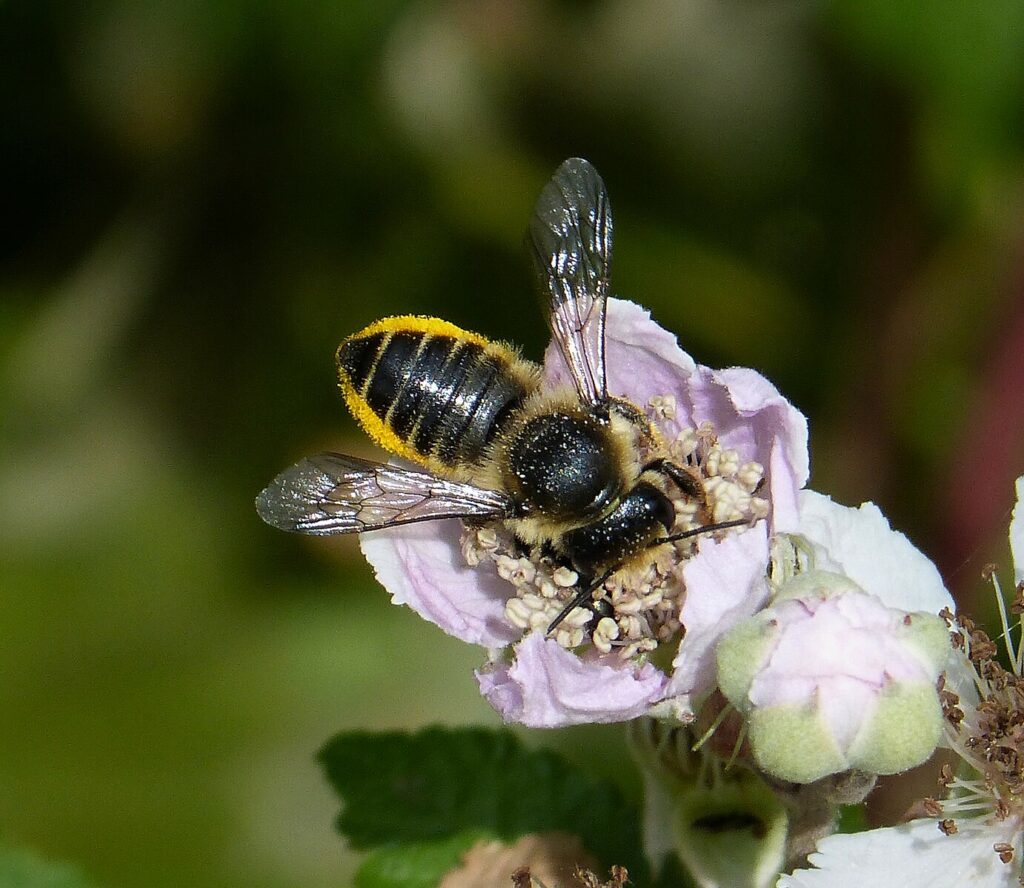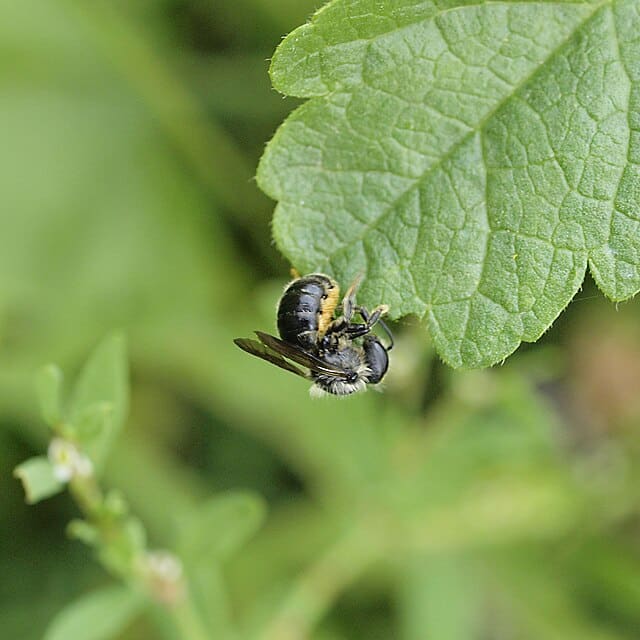Contents:
- What is a Leafcutter Bee?
- Types of Leafcutter Bees
- Leafcutter Bee Quick Facts
- Leafcutter Bee Biology and Behaviors
- Leafcutter Bee Habitat and Nests
- Male vs. Female Leafcutter Bees
- How to Identify a Leafcutter Bee
- Leafcutter Bee Control, Prevention, and Removal
- FAQs
What Is A Leafcutter Bee?
In our pollination article, we learned that bees are the best animal pollinators. In the US, there are over 4,000 species of native bees, including carpenter bees, mason bees, and the subject of this article – leafcutter bees.
Leafcutter bees are solitary bees of the Megachile genus, and about 242 species of leafcutters are native to North America. Leafcutter bees, along with mason bees (genus Osmia) and a few other genera, make up the larger Megachilidae family. The Megachilidae family is known as the architects or builders of the bee world, as they create tunnels or chambers for their offspring to hatch in.
Like mason bees, leafcutter bees are ‘cavity nesting’. This means they make their nests in ready-made cavities, twigs, or in soft rotting wood that can be ‘excavated’ to create these chambers.
The name “leafcutter” is well deserved. These bees chew round, circular pieces from the leaves of plants to use in the making of their nests. These pieces are very small and meticulously cut, like carved half-circles in the edges of the leaves.
Many late season fruits and vegetables depend on leafcutter bees for pollination. Some leafcutting bees are even used as commercial pollinators (like honey bees) in crops such as alfalfa, carrots, and blueberries.
Types of Leafcutter Bees
Leafcutter bees are found around the world and are common in North America. In addition to the 242 species native to North America, there are non-native species that have been introduced from overseas for commercial pollination purposes – including the alfalfa leafcutting bee Megachile rotundata.
Other species include Megachile rubi, found in the eastern United States, and the faithful leafcutter bee (Megachile fidelis), found in the west and northwestern United States. However, the faithful leafcutter bee is not to be confused with the western leafcutter bee (Megachile perihirta), also found in the western United States but additionally in northern Mexico and southern Canada. These two species build very similar nests, but have slightly different reproductive behaviors. There is also the Texas leafcutter bee, Megachile texana, which is not only found in Texas but is native to the United States and southern Canada.
Leafcutter Bee Quick Facts
- Color: Dark, with bands of whitish hair on the abdomen. Females collect pollen on the underside of their abdomens using what is known as their “pollen brush” – when this brush is full of pollen, it can look like the female carpenter bee has a brightly colored belly.
- Number of legs: Six
- Shape: Female’s abdomens are triangular, while the males’ are more round and blunted.
- Antennae: Yes.
- Region: All continents except Antarctica. Although more species occur in the tropics than elsewhere, leafcutter bees can be found almost anywhere that flowering plants grow.
Leafcutter Bee Biology and Behaviors
Diet: Leafcutter bees do not eat the leaves and petals of plants. Like honey bees, they feed on flower nectar and pollen from a wide variety of plants. Legumes and sunflowers are popular foraging sources for leafcutter bees, as well as wildflowers and summer fruits and vegetables, such as tomatoes, melons, peas, blueberries, and more. The alfalfa leafcutter bee, Megachile rotundata, is especially important for pollinating alfalfa plants – the nutritious crop fed to livestock.
Lifecycle: Leafcutter bees are solitary bees; they do not form colonies and they don’t have queens. The individual female leafcutter bees do all of the work locating nesting sites, creating nest cells out of leaf and petal fragments, and providing the eggs with food. Adult females may live up to two months and lay between 30 to 40 eggs.
The eggs hatch and larva development occurs within the nesting cells made of leaf fragments. Inside the nest cell, the larvae develop over the winter and pupate in the early spring, emerging as adults a few weeks later. The males begin to emerge a few days prior to the females, so as soon as the females emerge, they mate with the waiting males. The males only live for a short period of time after mating – the females go on to seek out potential nesting sites.
Pollination: A big difference between leafcutter bees and honey bees is how they forage. Honey bees carry pollen in sacs on the outsides of their hind legs, whereas leafcutters carry pollen on the underside of their abdomen. They have a special hairlike structure, kind of like a patch of Velcro, called a ‘pollen brush’ that picks up pollen as they move from one plant to another. This system also means that pollen often falls as they land, making them very effective pollinators.
Reproduction: A leafcutter bee will create a dozen or more nesting cells within the nesting cavity she has either selected or excavated. She will provision each cell with a mixture of pollen, nectar, and her saliva, and then lay an egg in the cell. If the egg is a male, she will place him closer to the opening of the cell, so he can exit early and be ready to mate with the females once they emerge.
Leafcutter Bee Habitat and Nests

Starting in late spring and into late summer, the leafcutter bee builds her nest in wood cavities, typically rotten wood, or in tunnels carved into hollow stems, or in cavities dug in the ground. Leafcutter bees can find suitable nesting sites in a wide range of habitats, including deserts, coastal dunes, prairies, shrublands, gardens, and more.
They typically look for pre-existing cavities; these bees are happy to make their nests in tunnels made by beetles or other insects, as well as cracks and holes in man-made structures.
Upon locating a suitable cavity, females begin gathering round or oval pieces of leaves that they cut themselves. They take these pieces and overlap them, sealing them with a secretion until they form an individual cell in a cylindrical ‘cigar’ shape. Some species line their egg cells with petals instead of leaves.
A typical nest consists of a dozen or more of these cells, packed tightly together. After provisioning the cells with food and laying a single egg in each one, the final task of the female leafcutter bee is to close each cell with a seal made of chewed up leaves. This protects the developing bees through the winter until they are ready to emerge as adults in the spring.
Male vs. Female Leafcutter Bees
Female leafcutter bees are larger than the males and have a triangular shaped abdomen that ends in a point. They do have stingers, but these bees are non-aggressive, and their stings are far less painful than those of a wasp or honey bee. The males can be identified by their smaller, blunt abdomens (no stingers) and their long antennae. Males have green eyes while the females have black eyes.
How To Identify A Leafcutter Bee

Leafcutter bees are about the same size as honey bees, but they are black with several whitish bands of hair across their abdomens. These bees tend to have a larger head than most bees because of the extra muscles they developed to help them chew through leaves – the females even have teeth!
A key way to identify leafcutter bees is by looking for the pollen brush. If the bee has picked up pollen, it will look as though she has a brightly colored belly.
Leafcutter Bee Control, Prevention, and Removal
Unlike insects that feed on plant leaves, leafcutter bees take only what they need for constructing their nest. The holes they leave behind are small and do not usually impact the health of the plant.
Insecticides are not recommended, nor are they effective for this insect. Leafcutter bees don’t actually feed on the leaves, so most sprays will not work. Because they are such efficient pollinators, these bees are helpful gardening allies, rather than a pest that needs removal. Using insecticides will kill other beneficial insects too.
If you want to protect a prize plant in your garden, try covering it with cheesecloth or dense netting until the bees have finished building their nests.
FAQs
Q: Do leafcutter bees sting?
A: Only the females have stingers, and they are very non-aggressive. If in the unlikely event one was to get stung by a leafcutter bee, the sting would not be as painful as those of wasps or honey bees, because the leafcutter bee lacks barbs and venom.
Q: What do leafcutter bees eat?
A: Leafcutter bees forage from a wide variety of flowering plants to obtain pollen and nectar. They do not eat leaves or petals.
Q: What does a leafcutter bee look like?
A: A leafcutter bee is around the same size as a honey bee, but black with white stripes across the abdomen. They also have larger heads, and the females have mandibles for chewing through leaves.
Q: Where do leafcutter bees live?
A: Leafcutter bees can be found all over the world, in every continent except for Antarctica.







